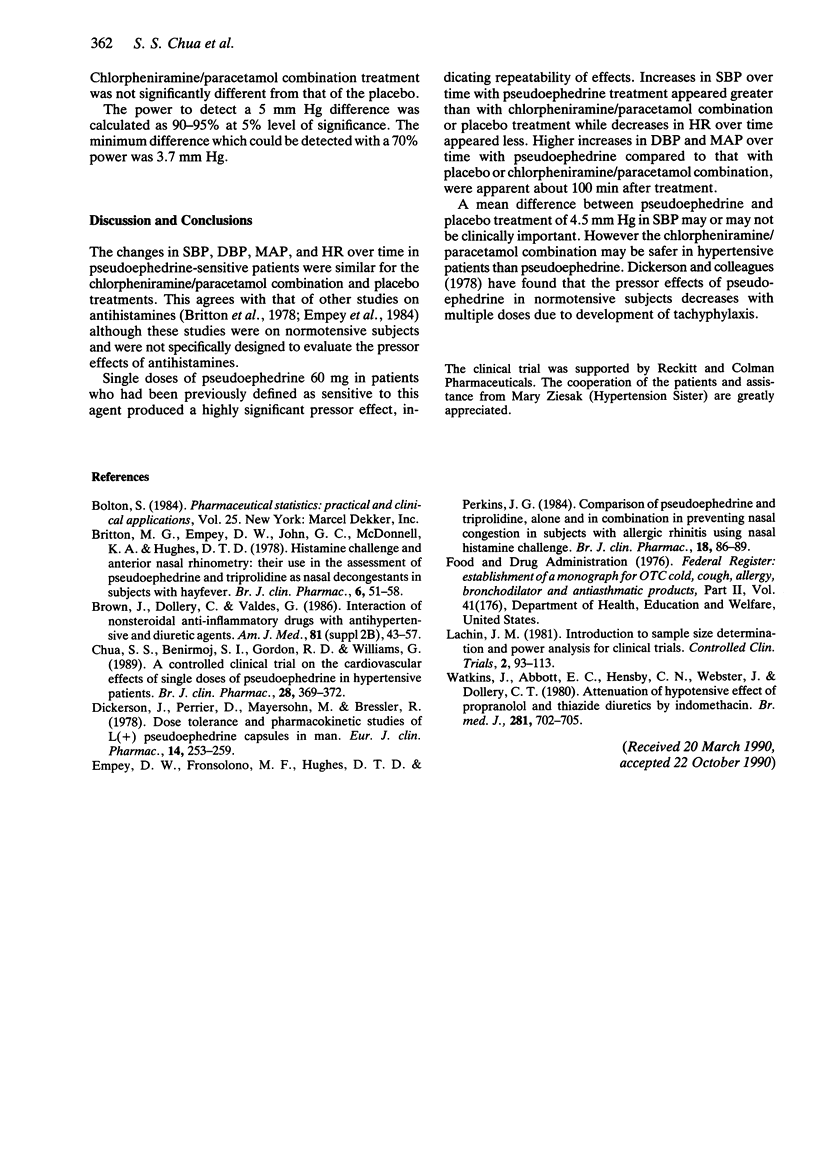Abstract
Twelve hypertensive patients who were classified as pseudoephedrine-sensitive in a preliminary trial were selected for further investigation with single doses of pseudoephedrine 60 mg, a combination of chlorpheniramine 4 mg with paracetamol 650 mg and placebo. A double-blind, randomised, crossover study design was followed. Treatment with pseudoephedrine produced significant effects on all the four variables measured (systolic, diastolic and mean arterial blood pressure, and heart rate). Effects of the chlorpheniramine/paracetamol combination were found to be not significantly different from placebo. It was concluded that the combination may be useful as a medication for 'colds' in hypertensive patients, since it does not induce cardiovascular effects such as those observed with pseudoephedrine.
Full text
PDF


Selected References
These references are in PubMed. This may not be the complete list of references from this article.
- Britton M. G., Empey D. W., John G. C., McDonnell K. A., Hughes D. T. Histamine challenge and anterior nasal rhinometry: their use in the assessment of pseudoephedrine and triprolidine as nasal decongestants in subjects with hayfever. Br J Clin Pharmacol. 1978 Jul;6(1):51–58. doi: 10.1111/j.1365-2125.1978.tb01681.x. [DOI] [PMC free article] [PubMed] [Google Scholar]
- Brown J., Dollery C., Valdes G. Interaction of nonsteroidal anti-inflammatory drugs with antihypertensive and diuretic agents. Control of vascular reactivity by endogenous prostanoids. Am J Med. 1986 Aug 25;81(2B):43–57. doi: 10.1016/0002-9343(86)90907-1. [DOI] [PubMed] [Google Scholar]
- Chua S. S., Benrimoj S. I., Gordon R. D., Williams G. A controlled clinical trial on the cardiovascular effects of single doses of pseudoephedrine in hypertensive patients. Br J Clin Pharmacol. 1989 Sep;28(3):369–372. doi: 10.1111/j.1365-2125.1989.tb05441.x. [DOI] [PMC free article] [PubMed] [Google Scholar]
- Dickerson J., Perrier D., Mayersohn M., Bressler R. Dose tolerance and pharmacokinetic studies of L (+) pseudoephedrine capsules in man. Eur J Clin Pharmacol. 1978 Dec 1;14(4):253–259. doi: 10.1007/BF00560458. [DOI] [PubMed] [Google Scholar]
- Empey D. W., Frosolono M. F., Hughes D. T., Perkins J. G. Comparison of pseudoephedrine and triprolidine, alone and in combination in preventing nasal congestion in subjects with allergic rhinitis using nasal histamine challenge. Br J Clin Pharmacol. 1984 Jul;18(1):86–89. doi: 10.1111/j.1365-2125.1984.tb05026.x. [DOI] [PMC free article] [PubMed] [Google Scholar]
- Lachin J. M. Introduction to sample size determination and power analysis for clinical trials. Control Clin Trials. 1981 Jun;2(2):93–113. doi: 10.1016/0197-2456(81)90001-5. [DOI] [PubMed] [Google Scholar]
- Watkins J., Abbott E. C., Hensby C. N., Webster J., Dollery C. T. Attenuation of hypotensive effect of propranolol and thiazide diuretics by indomethacin. Br Med J. 1980 Sep 13;281(6242):702–705. doi: 10.1136/bmj.281.6242.702. [DOI] [PMC free article] [PubMed] [Google Scholar]


